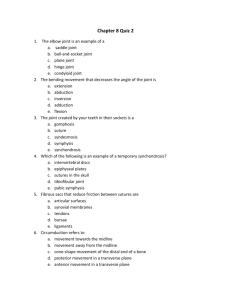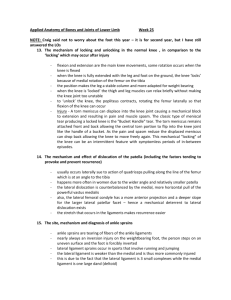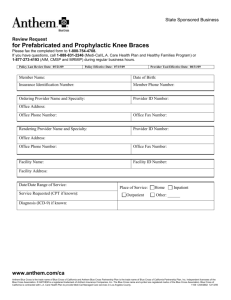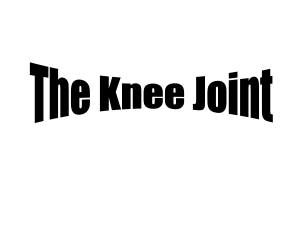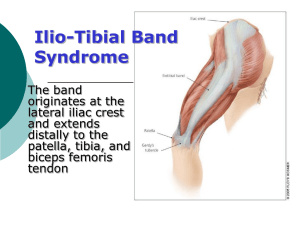The posterolateral corner (PCL) of the knee: Dynamic evaluation
advertisement
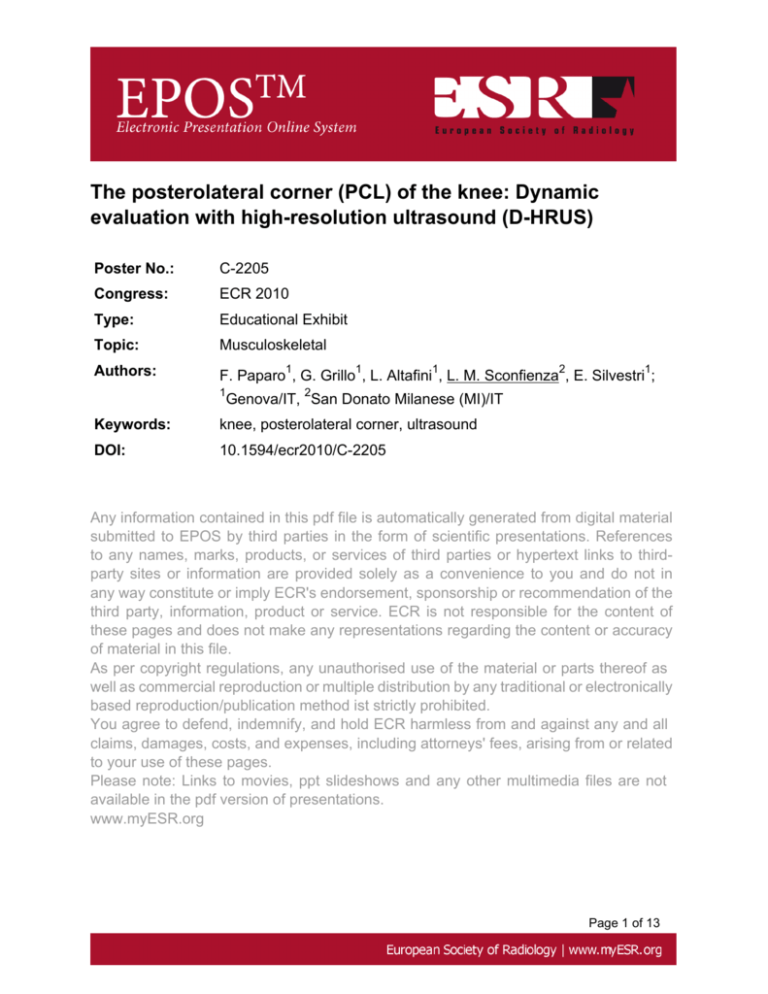
The posterolateral corner (PCL) of the knee: Dynamic evaluation with high-resolution ultrasound (D-HRUS) Poster No.: C-2205 Congress: ECR 2010 Type: Educational Exhibit Topic: Musculoskeletal Authors: F. Paparo , G. Grillo , L. Altafini , L. M. Sconfienza , E. Silvestri ; 1 1 1 1 2 1 2 Genova/IT, San Donato Milanese (MI)/IT Keywords: knee, posterolateral corner, ultrasound DOI: 10.1594/ecr2010/C-2205 Any information contained in this pdf file is automatically generated from digital material submitted to EPOS by third parties in the form of scientific presentations. References to any names, marks, products, or services of third parties or hypertext links to thirdparty sites or information are provided solely as a convenience to you and do not in any way constitute or imply ECR's endorsement, sponsorship or recommendation of the third party, information, product or service. ECR is not responsible for the content of these pages and does not make any representations regarding the content or accuracy of material in this file. As per copyright regulations, any unauthorised use of the material or parts thereof as well as commercial reproduction or multiple distribution by any traditional or electronically based reproduction/publication method ist strictly prohibited. You agree to defend, indemnify, and hold ECR harmless from and against any and all claims, damages, costs, and expenses, including attorneys' fees, arising from or related to your use of these pages. Please note: Links to movies, ppt slideshows and any other multimedia files are not available in the pdf version of presentations. www.myESR.org Page 1 of 13 Learning objectives The purpose of our educational exhibit is to describe the normal sonographic anatomy of the PLC of the knee integrated with dynamic manoeuvers. Background The PLC of the knee is a group of structures that together form a functional complex of muscles, tendons, capsule, and ligaments. The main function of this complex is to oppose the internal rotational and translational forces that act on the knee. It is also effective in stabilizing the joint against varus movements. The PLC of the knee can be evaluated by magnetic resonance imaging (MRI). However, due its complexity and its superficial location, PLC visualization can be suboptimal. In addition, MRI evaluation of PLC can be limited by the exam performed with the knee in extension. Finally, some PLC injuries are only highlighted under stress, a condition that can be hardly reproduced during a MRI scan. HRUS seems to be the ideal imaging technique to evaluate the PLC of the knee. In fact, its very superficial location is easily and effectively reached using a high-resolution broadband linear array transducer (up to 18 MHz). Then, HRUS has the great advantage to examine the knee during flexoextension movements and under stress (e.g. with the patient standing on the floor), thus revealing small tears otherwise undetectable. Moreover, HRUS is cheaper and more readily available compared to MRI and can be used to perform an immediate comparative evaluation of the counterlateral knee. A number of previous studies both on cadavers and in living subjects described the sonographic appearance of normal anatomy of the PLC of the knee. However, none of them presents any dynamic image of such structures. Imaging findings OR Procedure details POPLITEUS MUSCLE AND TENDON Popliteus muscle and its tendon are the main dynamic stabilizers of the PLC of the knee. It takes origin proximally from the middle facet of the lateral surface of the lateral femoral condyle and inserts distally onto the posterior tibia. The tendon is intracapsular and runs behind the posterior wall of lateral meniscus where it gives some extensions. The function of the popliteus muscle is to rotate the femur on the tibia and assists the flexion of the leg upon the thigh. POPLITEOFIBULAR LIGAMENT Popliteofibular ligament is the main static stabilizer of the PLC of the knee. Popliteofibular ligament has a significant role in preventing excessive posterior translation and varus angulation, and in restricting excessive primary and coupled external rotation. It is a ligamentous structure descending from Page 2 of 13 the musculotendinous junction of the popliteus to the posterosuperior prominence of the fibular head, just adjacent to the insertion of the LCL. Half of this ligament is partially covered by the origin of the LCL. The arcuate ligament hides partially the PFL and it blends with it. In its distal two-thirds the orientation of the fibres of the popliteofibular ligament is nearly vertical and similar to that of the LCL. In its proximal one-third it fuse with the popliteal tendon and is orientated more obliquely. LATERAL COLLATERAL LIGAMENT The LCL is a round ligament that lies beneath the tendon of the biceps femoris muscle and runs from the lateral epicondyle, anterior to the origin of the gastrocnemius muscle, to the fibular head where it blends with the biceps femoris tendon. The LCL lies just posterior to mid-axial point of the knee and is the primary restraint to varus stress in the knee. The LCL is not connected with the meniscal capsule but it is separated by a thin fat pad. The LCL is tight when the knee is extended and it becomes loose when flexion exceeds 30°. BICEPS FEMORIS TENDON The biceps femoris tendon is a strong stabilizer of the PLC of the knee. The tendon inserts into the anterolateral side of the head of the fibula, and by a small slip into the lateral condyle of the tibia. At its insertion the tendon divides into two portions, which embrace the lateral collateral ligament of the kneejoint. From the posterior border of the tendon a thin expansion is given off to the fascia of the leg. Both heads of the biceps femoris perform knee flexion and help the extrarotation of the leg. LATERAL HEAD OF THE GASTROCNEMIUS Although the main function of gastrocnemious is plantar flexion, the lateral head acts as an important dynamic stabilizer of the PLC of the knee. The lateral head arises from the lower posterior surface of the femur above the lateral condyle, embedding also the fabella, when present. The tendon is very shorts and almost immediately it blends into the myotendineous junction. FABELLOFIBULAR LIGAMENT The fabellofibular ligament inserts on the apex of fibular styloid process and ascends vertically to lateral head of gastrocnemius where it blends with posterior termination of oblique popliteal ligament. The fabellofibular ligament is found deep between biceps tendon and lateral head of gastrocnemius. The fabellofibular ligament alone reinforces capsule in 20% when arcuate ligament is missing. When fabella is large, fabellofibular ligament is large, but arcuate ligament is not usually present. ARCUATE LIGAMENT The arcuate ligament is an extracapsular ligament of the PLC of the knee. It is usually Y-shaped, even though it can also be fan-shaped when fabella is missing. The main insertion is on the fibular head. From there, one arm runs over popliteus muscle and attaches on the posterior middle tibia. This arm could be missing when fabella is absent. The other arm blends with the proximal insertion of the lateral head of gastrocnemius on the lateral epicondyle of the femur. LATERAL GENICULATE ARTERY This structure is not properly a part of the PLC of the knee. However, knowing its anatomy is fundamental when evaluating such region, as it serves as an important anatomical landmark. Arising from the popliteal artery, it runs inferolaterally around the knee. In the PLC, it runs deeply to the lateral collateral ligament and superficially to the popliteofibular ligament. Images for this section: Page 3 of 13 Fig. 1: Popliteus muscle and tendon. F=femur; T=tibia; LM=lateral meniscus; white arrows=popliteus tendon; yellow arrows=popliteus muscle; asterisk=anisotropy artifact that hinders the proximal enthesis of popliteus tendon. Page 4 of 13 Fig. 2: Popliteofibular ligament. F=femur; T=tibia; LM=lateral meniscus; white arrows=popliteus tendon; yellow arrows=popliteus muscle; asterisk=anisotropy artifact that hinders the proximal enthesis of popliteus tendon. Fig. 3: Lateral collateral ligament. Extended field of view scan (EFOV) of the PLC of the knee. F=femur; T=tibia; LM=lateral meniscus; Fi=fibula; asterisk=popliteus tendon; white arrows=lateral collateral ligament. Fig. 4: Biceps femoris muscle and tendon. F=femur; T=tibia; LM=lateral meniscus; Fi=fibula; white arrows=biceps femoris tendon; yellow arrows=biceps femoris myotendineous junction. Page 5 of 13 Fig. 5: Lateral head of the gastrocnemius. F=femur; white arrows=lateral head of gastrocnemius muscle; asterisk=tendon insertion. Fig. 6: Fabellofibular ligament. arrows=fabellofibular ligament. Fa=fabella; F=femur; Fi=fibula; white Page 6 of 13 Fig. 7: Arcuate ligament. F=femur; T=tibia; Fi=fibula; white arrows=arcuate ligament; asterisk=lateral collateral ligament; yellow arrow=lateral geniculate artery. Fig. 8: Lateral geniculate artery. F=femur; PF=popliteofibular ligament; white arrows=lateral collateral ligament; asterisks=lateral geniculate artery. Page 7 of 13 Fig. 9: Dynamic evaluation of popliteofibular ligament during slight flexion of the knee and internal rotation. Page 8 of 13 Fig. 10: Dynamic evaluation of lateral collateral ligament during flexion of the knee and slight internal rotation. Page 9 of 13 Fig. 11: Dynamic evaluation of biceps femoris during slight flexion of the knee and internal rotation. Page 10 of 13 Conclusion HRUS is effective in the depiction of normal anatomy of the PLC of the knee. The dynamic evaluation of PLC structures is effective to understand the complex mechanism of stabilization of such area. Further studies on patients with PLC instability are needed to establish the clinical role of dynamic HRUS in the evaluation of such area. Personal Information 1 2 1 1,3 Francesco Paparo , Giovanna Grillo , Luisa Altafini , Luca M Sconfienza , and Enzo 4 Silvestri 1 Radiology Unit, Department of Internal Medicine University of Genova School of Medicine, Genova, Italy 2 Radiology Unit, Ospedale Santa Corona, Pietra Ligure, Italy 3 Radiology Unit, IRCCS Policlinico San Donato, San Donato Milanese, Italy 4 Radiology Unit, Ospedale Evangelico Internazionale, Genova, Italy Contact: io@lucasconfienza.it References 1. Sudasna S, Harnsiriwattanagit K. The ligamentous structures of the posterolateral aspect of the knee. Bull Hosp Jt Dis Orthop Inst 1990; 50:35-40 2. Theodorou DJ, Theodorou SJ, Fithian DC, Paxton L, Garelick DH, Resnick D. Posterolateral complex knee injuries: magnetic resonance imaging with surgical correlation. Acta Radiol 2005; 46:297-305 Page 11 of 13 3. Lee J, Papakonstantinou O, Brookenthal KR, Trudell D, Resnick DL. Arcuate sign of posterolateral knee injuries: anatomic, radiographic, and MR imaging data related to patterns of injury. Skeletal Radiol 2003; 32:619-627 4. Munshi M, Pretterklieber ML, Kwak S, Antonio GE, Trudell DJ, Resnick D. MR imaging, MR arthrography, and specimen correlation of the posterolateral corner of the knee: an anatomic study. AJR 2003; 180:1095-1101 5. Yu JS, Salonen DC, Hodler J, Haghighi P, Trudell D, Resnick D. Posterolateral aspect of the knee: improved MR imaging with a coronal oblique technique. Radiology 1996; 198:199-204 6. Rajeswaran G, Lee J, Healy J. MRI of the popliteofibular ligament: isotropic 3D WE-DESS versus coronal oblique fat-suppressed T2W MRI. Skeletal Radiol 2007; 36:1141-1146 7. Sekiya J, Jacobson J, Wojtys E. Sonographic imaging of the posterolateral structures of the knee: findings in human cadavers. Arthroscopy 2002; 18:872-881 8. Sugita T, Amis AA. Anatomic and biomechanical study of the lateral collateral and popliteofibular ligaments. Am J Sports Med 2001; 29:466-472 9. Watanabe Y, Moriya H, Takahashi K, et al. Functional anatomy of the posterolateral structures of the knee. Arthroscopy 1993; 9:57-62 10. Houghton-Allen BW. In the case of the fabella a comparison view of the other knee is unlikely to be helpful. Australas Radiol 2001; 45:318-319 11. Shahane SA, Ibbotson C, Strachan R, Bickerstaff DR. The popliteofibular ligament: an anatomical study of the posterolateral corner of the knee. J Bone Joint Surg Br 1999; 81:636-642 12. Gollehon DL, Torzilli PA, Warren RF. The role of the posterolateral and cruciate ligaments in the stability of the human knee: a biomechanical study. J Bone Joint Surg Am 1987; 69:233-242 13. Veltri DM, Deng XH, Torzilli PA, Maynard MJ, Warren RF. The role of the popliteofibular ligament in stability of the human knee: a biomechanical study. Am J Sports Med 1995; 23:436-443 Page 12 of 13 14. Harner CD, Vogrin TM, Höher J, Ma CB, Woo SL. Biomechanical analysis of a posterior cruciate ligament reconstruction: deficiency of the posterolateral structures as a cause of graft failure. Am J Sports Med 2000; 28:32-39 15. Barker RP, Lee JC, Healy JC. Normal sonographic anatomy of the posterolateral corner of the knee. AJR Am J Roentgenol. 2009;192:73-79. Page 13 of 13
